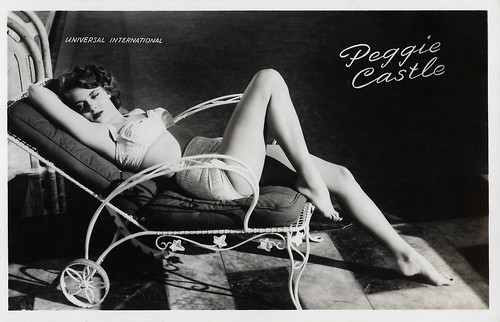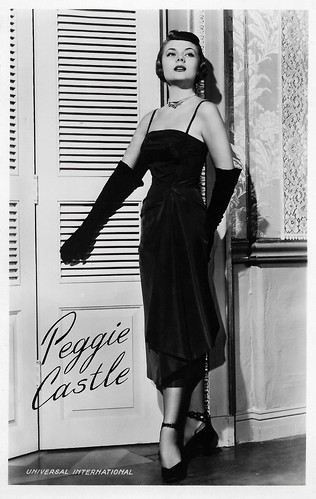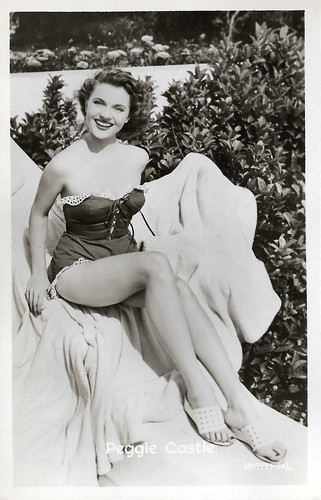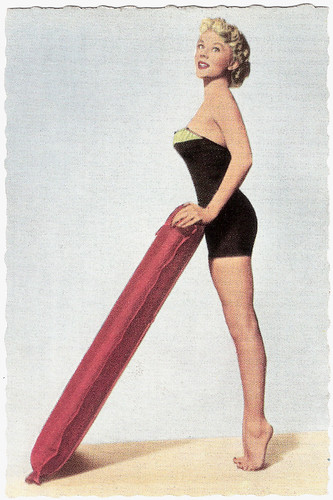
Dutch postcard by Takken, no. 461. Photo: Universal International.

Dutch postcard by Takken / 't Sticht, no. 160. Photo: Universal International.
Miss Classy Chassis
Peggie (sometimes written as Peggy) Castle was born as Peggy Thomas Blair in Appalachia, Wise County, Virginia, in 1927. Her mother was Elizabeth Blair. Her father, Doyle H. Blair, was a director of an industrial relations firm. When the family moved to Hollywood, he was hired as a studio manager at Goldwyn Studios. He also worked as a business manager for Donald O'Connor.
Later, Peggie changed her surname Blair at the first studio in which she worked. She took lessons in drama when she was 8 years old. Castle graduated from Hollywood High School and attended Mills College for two years. Castle's first work as an actress came in the soap opera 'Today's Children'. Then a spot on Radio Theatre in 1947 brought her a screen test offer from 20th Century Fox.
According to Hollywood lore, Castle was discovered by a talent scout while eating a shrimp cocktail in the seafood bar of the Farmer's Market in Beverly Hills. She was signed to a seven-year contract with Universal-International and made her film debut credited as Peggy Call in When a Girl's Beautiful (Frank McDonald, 1947) starring Adele Jergens.
In 1949, she was named "Miss Cheesecake" by the Southern California Restaurant Association. Later that year, the Junior Chamber of Commerce named Castle "Miss Three Alarm" and she was voted "Miss Classy Chassis" by members of the United Automobile Workers Union from seven Western states. That year, she also had a part in the comedy Mr. Belvedere Goes to College (Elliott Nugent, 1949), starring Clifton Webb as prickly genius Lynn Belvedere who enrols in a major university with the intention of obtaining a four-year degree in only one year.
In 1950, she was signed by Universal-International on instigation by Universal star Audie Murphy, whom she was seeing at the time. Hal Erickson at AllMovie: "Peggie Castle seemed to have stepped out of the pages of Mickey Spillane, and in fact starred in two films based on Spillane's works: I, the Jury (Harry Essex, 1953) and The Long Wait (Victor Saville, 1954) opposite Anthony Quinn.
During the 1950s, Peggie appeared in such films as the drama Payment on Demand (Curtis Bernhardt, 1951) starring Bette Davis, the technicolour Swashbuckler The Prince Who Was a Thief (Rudolph Mate, 1951) starring Tony Curtis and Piper Laurie, the Red Scare drama Invasion U.S.A. (Alfred E. Green, 1952), the Film Noir 99 River Street (Phil Karlson, 1953). Peggie Castle often starred in Westerns, appearing in nearly a dozen between Wagons West (Ford Beebe, 1952) starring Rod Cameron, and Hell's Crossroads (Franklin Adreon, 1957). Her later films also include the Science Fiction film Beginning of the End (Bert I. Gordon, 1957) and Arrivederci Roma/Seven Hills of Rome (Roy Rowland, 1957) with tenor Mario Lanza and Marisa Allasio.

British postcard in the Picturegoer Series, London, no. D. 85. Photo: Universal International.

Vintage card. Photo: Universal.
The Case of the Negligent Nymph
In the late 1950s, Peggie Castle moved into television. She appeared in multiple guest roles on Fireside Theater, Cheyenne, 77 Sunset Strip, and The Restless Gun. In 1957 she appeared as Amy Gordon opposite Clint Walker on Cheyenne in the episode titled The Spanish Grant. In 1957 she played defendant Sally Fenner in the Perry Mason episode, The Case of the Negligent Nymph.
Also in 1957, she was a primary star on Gunsmoke, playing a forlorn Nita Tucker in the episode Chester’s Murder. From 1959 to 1962, she co-starred in the television Western series Lawman — her first continuing series. Her role as saloon owner Lily Merrill brought out a new dimension of Castle's talent. She stated, "For the first time in my life I'm a singer — that's the producer's opinion, not mine."
Her final on-screen role was a guest appearance in a 1966 episode of The Virginian. In 1958, Castle acted with Jesse White in a stage production of 'A Hole in the Head' at the Civic Playhouse in Los Angeles. In 1960, Castle and Peter Brown (who also was a regular in Lawman) travelled to rodeos, performing as a song-and-dance team. Castle stressed, "We're very careful not to sing any romantic songs," treating the act more like a brother-sister team. The duo's stops included St. Louis, Chicago, Detroit, Pittsburgh, and Albuquerque.
In 1960, she received a star on the Hollywood Walk of Fame. Castle was married four times. She married Revis T. Call, a 2nd Lieutenant in the Army in 1945, in Los Angeles. Following that marriage, she began using Peggy Call as her professional name. They divorced in 1950. She married Universal publicist Robert H. Raines in 1951 and they divorced in 1954.
In 1955, Castle married producer and director William McGarry. They had a daughter, Erin McGarry. Castle divorced McGarry in 1969. In 1971, she married Arthur Morganstern, her fourth husband. They remained married until Morganstern's death in 1973. Castle suffered from alcoholism. In 1969, she attempted suicide by taking an overdose of barbiturates and slashing her wrists. She was later committed to California's Camarillo State Hospital for her alcoholism, but she regressed after her release. In 1973, her third husband, William McGarry found her body on the couch of her Hollywood apartment. Her death was later determined to be caused by cirrhosis. She was only 45.

German collector's card by Druckerei Hanns Uhrig, Frankfurt a. M. Photo: Warner Bros. Pictures, Inc.

West-German card by Kolibri-Verlag, no. 1486. Photo: United Artists. Peggie Castle in The Long Wait (Victor Saville, 1954).
Sources: Hal Erickson (AllMovie), Wikipedia and IMDb.
No comments:
Post a Comment